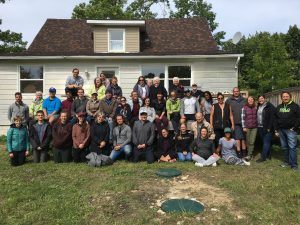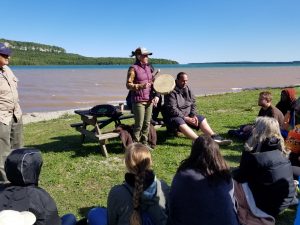Lindsay Burrows and Professor Heidi Stark share Anishinaabe law stories
Ioana Dragalin (2L)

Photo credit: Jesse Johnston
This September, I had the opportunity to visit Neyaashiinigmiing, the Cape Croker Indian Reserve, along with almost 30 students and professors from the University of Toronto Faculty of Law. Several members of the Law Society of Ontario, including Treasurer Malcolm Mercer, joined us to learn from Lindsay Keegitah Borrows and Professor Heidi Kiiwetinepinesiik Stark, experts on Anishinaabe law.
Although almost all of the classes offered by the Faculty provide some exposure to Aboriginal legal issues, accounts of Indigenous culture and tradition are less common.
My goals for the three-day excursion were to engage with the Anishinaabe community and surrounding landscape, learn more about Anishinaabe traditions and teachings, and inform my understanding of the duties that law students and legal professionals have with respect to reconciliation.
I am unable to share the teachings that I received in detail as I am neither Anishinaabe nor a Knowledge Keeper and am therefore unable to speak for the community. Instead, I hope that my reflection on what I learned and experienced will encourage other students to seek out similar opportunities to better their understanding of Indigenous legal and cultural traditions.

Stories are an important source of Anishinaabe law. Many lessons over the course of the weekend involved one or more stories that would illustrate various legal concepts. After listening to a story, we would break off into smaller groups and discuss the story’s meaning. At first, I found this exercise very difficult—how are we supposed to figure out the true meaning of a story without any prior exposure to Anishinaabe law?
After listening to a couple of stories and finding their vagueness frustrating, I came to a realization. From what I understand, the stories are meant to be ambiguous. In fact, it is possible for each listener to come away from a story with a different teaching or understanding of its underlying meaning. The point of the exercise is to explore the teachings that each story can offer you rather than to pinpoint a specific lesson for which the story is meant to stand.
Moving forward, I hope to approach unfamiliar situations using this methodology. As a law student and as a young associate, it seems that there is often a focus on finding the answer that someone else is looking for, whether they are a professor or a supervising lawyer. This mindset can create mental barriers that limit your ability to come up with creative solutions to legal problems. By approaching new ideas with the goal of learning for yourself rather than for those around you, you put yourself in a better position to engage deeply with the material in a way that encourages creative and empathetic solutions.
In addition to storytelling, the weekend included a sweat lodge ceremony as well as exposure to cultural traditions that I do not have enough room to discuss. It’s difficult to explain how or why I have felt closer to the environment since my return and impossible to describe how the sweat lodge ceremony I participated in affected my spiritual well-being and mental health. What I can say is that I hope this small glimpse into the program has convinced you to attend next fall, because the experience is unique and memorable.





